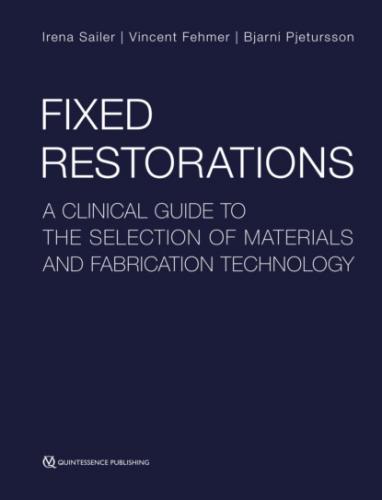Fixed Restorations. Irena Sailer
Figs 1-4-13 a to f 3D-printed surgical guide, based on guided surgery planning, transferring the relevant information of the virtually planned 3D implant position into the clinical situation. This specific guide (SMOP, Swissmeda) is an example of a digitally designed and printed surgical guide, allowing for excellent visibility of the surgical site, position accuracy, and enabling the surgeon to cool the surgical site during the implant bed preparation with sterile saline solution.
Figs 1-4-13 g to 1-4-13m 3D-printed surgical guide, based on guided surgery planning, transferring the relevant information of the virtually planned 3D implant position into the clinical situation. This specific guide (SMOP, Swissmeda) is an example of a digitally designed and printed surgical guide, allowing for excellent visibility of the surgical site, position accuracy, and enabling the surgeon to cool the surgical site during the implant bed preparation with sterile saline solution.
Creating a digital wax-up directly via the planning software
With this option, it is not only possible to upload and match the surface scan data of the current intraoral situation with the 3D CBCT data (as with options 1 and 2), but also to create a digital wax-up directly with the planning software. This workflow is highly efficient because the steps involved in displaying and then scaling and correctly positioning the virtual wax-up in the software can be completed very fast33,34.
Most guided surgery systems today are intended for planning purposes only. They are equipped with rather rudimentary tooth libraries and design software tools that are, however, sufficient for single-tooth implant planning in situations with sufficient prosthetic references, like the adjacent teeth, albeit if used for cantilever and multispan fixed/removable dental prostheses restorations, proper adaptation and positioning of the virtual teeth can be very difficult.
There is great potential for the new generations of CAD/CAM software to fill this gap. Through the merging or modular docking of implant-planning software with the manufacturing software used in the dental laboratory, digital implant planning can now be performed in the virtual articulator with modern design tools, taking all the relevant information (such as the soft tissue margins) into consideration. The data can then be visualized in the implant-planning software in real time by creating a specific connection to the implant manufacturer (eg, Straumann DWOS Synergy Connection, Straumann, Basel, Switzerland). This allows the dental technician to continuously adapt the wax-up, and the clinician to change the implant position in the software module. After the implant-planning proposal has been finalized and approved, the dental technician designs the surgical guide using the software elements intended for dental laboratory use. The planned guide can be milled or 3D printed either in-house or by an external provider, which is sent to the corresponding datasets. This blending of software solutions also opens up new possibilities, eg, it is possible to design and manufacture temporary provisional restorations or abutments directly by utilizing the planned implant positions without having to laboriously export them from the planning software and then reimport them into the design software. In principle, the positioning of splints can be used to guide Part or all of the implant site preparation process. Some also allow for implant placement via the guide. Ultimately, it is up to surgeons to decide how much autonomous control they have over the entire process, ie, how much they want to rely on the planning software and surgical guide.
The introduction of 3D diagnostic imaging technologies and the corresponding implant-planning software packages has fundamentally changed and significantly improved pre-implantation diagnostics and planning.
The pretreatment diagnostics is a crucial step within the comprehensive restorative treatment, as it serves for better communication between the patient and the restorative team, and for the planning and execution of the respective treatment steps including the placement of dental implants. Until recently, pretreatment wax-ups and setups were made manually by the dental technician. Nowadays, the digital technology can be used for virtual diagnostics, and CAD/CAM technology helps in transferring this plan into clinical reality. An increase in efficiency and predictability by means of virtual diagnostics has been shown. Yet, availability of the technology, knowledge of its application, and high acquisition costs have to be considered with the virtual diagnostics.
1. Magne P, Magne M, Belser U. The diagnostic template: a key element to the comprehensive esthetic treatment concept. Int J Periodontics Restorative Dent 1996;16:561–569.
2. Reshad M, Cascione D, Magne P. Diagnostic mock-ups as an objective tool for predictable outcomes with porcelain laminate veneers in esthetically demanding patients: a clinical report. J Prosthet Dent 2008;99:333–339.
3. Simon H, Magne P. Clinically based diagnostic wax-up for optimal esthetics: the diagnostic mock-up. J Calif Dent Assoc 2008;36:355–362.
4. Coachman C, Calamita M. Digital smile design – a tool for treatment planning and communication in esthetic dentistry. QDT 2012;35:1–9.
5. Fradeani M. Evaluation of dentolabial parameters as Part of a comprehensive esthetic analysis. Eur J Esthet Dent 2006;1:62–69.
6. Couto Viana P, Correia A, Neves M, Kovacs Z, Nrugbauer R. Soft tissue waxup and mock-up as key factor in a treatment plan: case presentation. Eur J Esthet Dent 2012;7:310–323.
7. Salama M, Coachman C, Garber D, Calamita M, Salama H, Cabral G. Prosthetic gingival reconstruction in the fixed partial restoration. Part 2: diagnosis and treatment planning. Int J Periodontics Restorative Dent 2009;29:573–581.
8. Kahng LS. Patient-dentist-technician communication within the dental team: using a colored treatment plan wax-up. J Esthet Restor Dent 2006;18:185–193; discussion 194–185.
9. van Noort R. The future of dental devices is digital. Dent Mater 2012;28:3–12.
10. Schenk R. Biogeneric – another step closer to nature. Int J Comput Dent 2010;13:169–174.
11. Kurbad A, Kurbad S. Cerec smile design – a software tool for the enhancement
